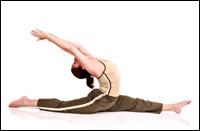 Workout injuries can put you out of commission for weeks or sometimes months. Fitness expert Meredith Miller of Level 10 Fitness shares a plethora of tips to help prevent injuries while getting in shape.
Workout injuries can put you out of commission for weeks or sometimes months. Fitness expert Meredith Miller of Level 10 Fitness shares a plethora of tips to help prevent injuries while getting in shape.
Warm Up
One of the most important ways to avoid injury is to do a comprehensive warm-up before every workout. Your starting point should be between six to 10 minutes, or until you have broken a light sweat. This raises the body’s core temperature enough to enhance the elasticity of muscles, tendons, ligaments and overall joint structures, which prepares you for the tough workout ahead.
Cool Down
After exercising, cool down. Decrease the intensity of your exercise and continue to move for five more minutes, then do slow, static stretching for another five to 10 minutes. Cooling down helps your body adjust. It allows a proper decrease in heart rate and blood pressure, prevents blood from pooling in your legs and promotes the removal of lactic acid, which helps decrease muscular soreness. Make sure to stretch slowly and gently, stopping short of pain. Inhale and exhale regularly.
Wear the Right Shoes
The right shoes should fit well and be designed specifically for the activity you are involved in.
Proper Rest
If you are tired or did not get a sufficient amount of sleep, cut down on the duration or intensity of the exercise. Also, give your body adequate time to recover, ideally 24 to 48 hours. Your muscles need recovery.
Hydrate
It is important to drink before, during and after exercise. Water is your body’s principal chemical component, comprising 60 percent of your weight on average. Every system in your body depends on water. Water flushes toxins out of vital organs, carries nutrients to your cells and provides a moist environment for ear, nose and throat tissue.
However, learn to sip, and not gulp! Give your body time to absorb what you are drinking, instead of drinking so much that it doesn’t know what to do. The more you exercise, the more fluid you’ll need to stay hydrated. An extra one or two cups of water should suffice for short stints of exercise, but intense activity lasting more than an hour (for example, running a marathon) requires additional fluid. How much you intake depends on the amount you sweat during the exercise, but 13 to 26 ounces (or about two to three cups) an hour will generally be adequate, unless the weather is exceptionally warm.
During long bouts of intense exercise, it’s best to consume a sports drink that contains sodium, as this will help replace sodium lost in perspiration and reduce the chances of developing hyponatremia, which can be life threatening. Fluid should also be replaced after exercise. Drinking 16 ounces of fluid per pound of body weight lost during exercise is recommended.
Exercising in Warm Weather
Drink plenty of water — don’t wait until you are thirsty. Wear light-colored, lightweight, loose-fitting clothes, as well as a hat or sun visor, sunglasses and sunscreen. Exercise slower with less intensity and be aware of symptoms of heat exhaustion: weakness, dizziness, rapid pulse, headache, muscle cramps, decreased sweating, nausea. In extreme heat, exercise early in the day or later in the evening.
Exercising in Cold Weather
Wear a hat and warm clothing to prevent heat loss. Avoid overdressing, therefore, wear layers that can be removed as you warm up. Wear loose clothing — it traps layers of air and provides good insulation. Water increases the rate of heat loss and decreases the insulation value of clothing, so remove damp or wet clothing as soon as possible.
Heed the Pain
Do not ignore pain — it’s your body’s response to injury or overuse. As you get accustomed to exercise, you will be able to better distinguish between soreness and pain. Soreness may develop one to two days after a workout and dissipate 24 to 48 hours later. Pain can occur immediately and persist in everything you do.
Do Not Over Train
Make sure that your frequency and intensity are within reason — don’t exercise too often or too hard. Give your body enough time to recover from an intense workout (24 to 48 hours). If you feel like you have an impending illness, take a break. Overtraining when you are on the brink of getting sick only wears your immune system down further.
Got Injury?
For treatment of minor injuries, ice it, baby! Rest the injured area by reducing activity and immobilizing it. Ice the injured area for 20 minutes on, with 40 minutes off, to help decrease inflammation and pain. Compress the injured area by wrapping it for at least 30 minutes to prevent swelling and elevate it above the level of your heart. If pain or swelling worsens after 24 hours, see a physician.
Eat for Injury Prevention
Eating fresh food that is in season and full of nutrients will help you stay healthy and reduce the possibility of injury. Brightly colored vegetables contain natural antioxidants, vitamins and minerals that the body can use to detoxify, heal and decrease inflammation.
If you are recovering from an injury, avoid inflammatory foods such as coffee, chocolate, dairy, sugar, potatoes, corn, peanuts and wheat. These are difficult for the body to digest and create inflammation. With less inflammation, your pain will decrease and your body will heal more effectively. You will also experience other benefits from these simple dietary changes.
Chaton Anderson is a Writer and the Publicity Director for TheSavvyGal.com. A product and pop culture addict, she is always looking for the coolest, hippest things on the market. Email her at Chaton@TheSavvyGal.com with questions or leads on products and services on the cutting edge.
